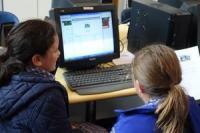Home-Behind the books
- Peter Fitzgibbon Library
- Building memories
- Our Librarian Mrs Clarke
- Cross glory
- Holy vintage
- Clippings past and present
- Cultural mix
- Book issues
- How we use the library in 2014
- Memories from the past
- A parent's view
- The National Library of New Zealand Te Puna Matauranga O Aotearoa
- The Alexander Turnbull Library
- Sister de Porres, Archivist
- Our team
- Research and inquiry process
- Learning outcomes
- References and acknowledgements
Learning outcomes
We have learnt that the oldest book in the National Library, and Catholic Archives of Wellington is a bible and that is the same as our school library. This also tells us about the history of New Zealand the Missionaries.
Bibles are historic items and are an old and ancient book. For us our bible also reflects our Catholic character.
A library is not just a place for issuing books but is also a place of displays, research, and storing our school’s history. A school library is like an archives for the school.
Libraries are a special taonga that hold important information for future generations.
Our classroom used to be the school library and the new library now uses the space in a different way. The physical shape and space of the library has changed over time because the way we learn is different today. Books came from the merger of both schools, Holy Cross and Marist Miramar.
The National library is a unique place because it has the Alexander Turnbull Library in it as well.
Newspaper clippings are an important way of recording history and both our school library and the National Library do this.
Our library is used in many different ways from reading books, to study, to community meetings.
It is important that libraries have names that show what they do and who they represent.
Father Fitzgibbon was passionate about the library and made sure that it got built, so our library is named in honour of his work and dedication.
From our interview questions we were able to find out how teachers used the library for their students and how much value they saw in the library.
Our library has photos of our history and the National Library also stores photos that record history.
Libraries reflect the cultures of their communities in many different ways through books and displays and exhibitions.
At the National Library there was a desk called lifelines and you could find out about your family history. Libraries store history in different ways like photos and with technology.





